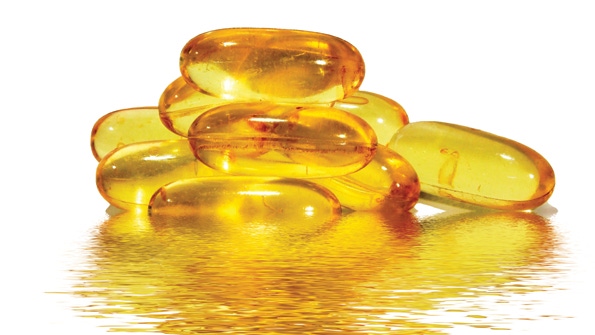Studies show omega-3 benefits may include brain development, heart health, eye health, cognitive function, decreased depression, bone health, immunity, and even reduced cancer risk.
December 15, 2010

Fish oil has come a long way from its humble roots as grandmother’s' standby, fishy-tasting cod-liver oil. Today, 30 percent of U.S. adult supplement users take omega-3 essential fatty acids (EFAs) supplement, according to the Council for Responsible Nutrition.

Why all the interest? Omega-3s have beneficial anti-inflammatory effects in the body. Studies show omega-3 benefits may include brain development, heart health, eye health, cognitive function, decreased depression, bone health, immunity, and even reduced cancer risk. Read on for insights on how and why to load up on fish oil.
Omega-3s top health benefits
Heart health: Docosahexaenoic acid (DHA) and eicosapentaenoic acid (EPA) in oily fish and fish oil work together to lower triglycerides and raise HDL (good) cholesterol by helping with fat metabolism; also may help with hypertension and preventing heart attacks.
Brain health: Found in human breast milk and in high concentrations in the brain itself, DHA may help with brain development in infants, as well as protect cognitive function in aging adults.
Other: Recent studies show omega-3 supplements can also help lift major depression, boost immunity in infants, and slow macular degeneration in older adults. Bone health, weight management, and reduced cancer risk are other possible benefits; more clinical trials are needed.
Omega-3s by type
Docosahexaenoic acid (DHA): Found in oily fish, algae, breast milk, and - —in large concentrations - —in the brain itself. Important for heart health and brain development; often added to infant formula.
Eicosapentaenoic acid (EPA): Also found in oily fish, EPA works in conjunction with DHA and may especially benefit heart health.
Alpha-linolenic acid (ALA): Found in plants, especially nuts and seeds such as walnuts and flaxseed. Some ALA gets converted into EPA and DHA in the body, but it''s not clear if amounts are enough. Still, both fish oil and plant sources offer benefits.
Fish oil for condition
Fish sources
Anchovies, sardines
What’'s in them: EPA and DHA
Best for: Adults and children older than 2
The lowdown: Most fish oil products are derived from these small fish, generally caught off the coasts of Peru and Chile. Because they feed on tiny ocean creatures, experts say they'’re safe and relatively sustainable. Plus, affordable and more concentrated.
Dose: 1,000 mg daily
Salmon, cod
What’'s in them: EPA and DHA
Best for: Adults and children older than 4
The lowdown: Although large fish can accumulate toxins such as PCBs, reputable manufacturers successfully remove contaminants by flash-distilling oils using steam or by molecularly distilling them in a vacuum. Choose trusted brands; only consume clean oils that carry a freshness and purity guarantee right on the label. Steer clear of shark products.
Dose: 1,000 mg daily
More omega-3 articles
More support for omega-3s and healthy baby development
What is the difference between omega-3 and omega-6 fatty acids?
Omega-3s may help ward off Alzheimer's, study shows
Safety of your supplement
A San Francisco lawsuit made headlines this spring by fingering five fish oil manufacturers for unsafe levels of PCBs, particularly in liver oil products. Although these findings are worrisome, they're not a good reason to stop taking fish oil, experts say. In fact, fish oil supplements have lower levels of contaminants than most types of fish, especially when you consider comparative quantities consumed, says Timothy Fitzgerald, senior policy specialist at the Environmental Defense Fund. Here's how to make sure your supplement is safe.
Choose supplements made from smaller fish. If the bottle doesn't specify the kind of fish, it is likely from small, low-contaminant species such as sardines and anchovies
Don't take too much. A product may comply with industry standards based on taking one pill a day, but its label may recommend a higher dose, says Fitzgerald. Even though a small dose is nontoxic, a higher dose taken daily over time may become toxic. Finally, high doses (3,000 mg a day or more) can cause bleeding. Check with your health care provider if you take blood-thinning medication such as warfarin.
Go with a brand or a store that you trust. Ask at your local retailer about product-quality standards and recommended brands.
You May Also Like


